If you read my previous post Grape Harvest and Winemaking you will know that it came as something of a surprise to us to find ourselves making wine this Autumn.
On Friday morning the fifteenth of October, after the grape pulp had been fermenting for just over four days we went next door to our neighbours to continue our lesson in wine making, the Italian country way. It is actually an extremely straight forward and simple process, certainly for the white wine that we are making with no artificial additives what so ever.
The first two pictures show our barrels, with the fermentation now at the stage where the barrels were about to overflow it was time to drain the liquid off from the pulp and transfer it into our wine making demi johns.
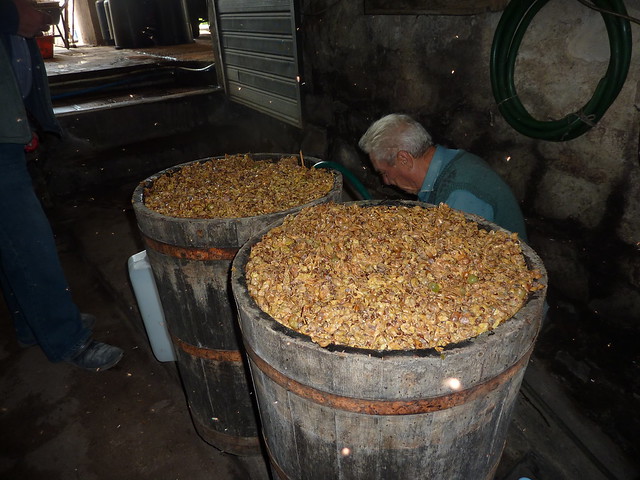
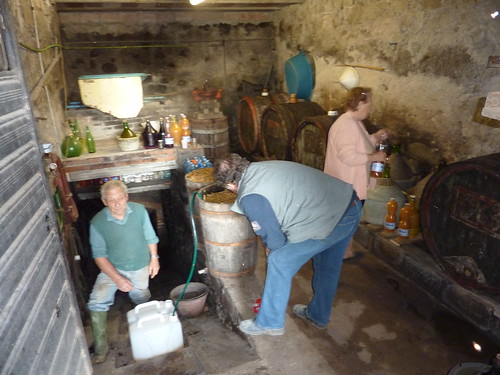
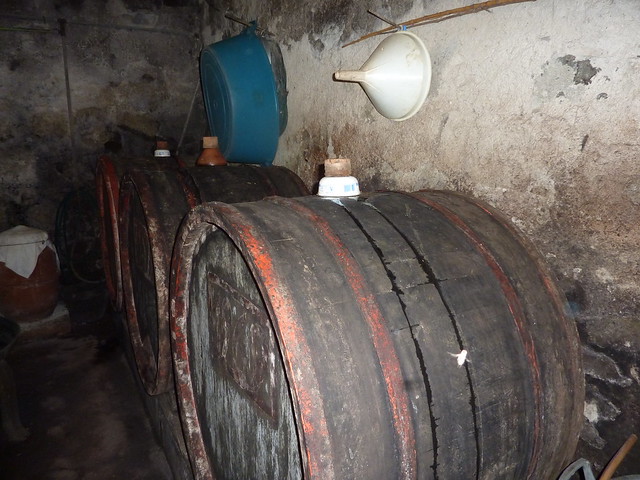 Just some our neighbours white wine fermenting in barrels.
Just some our neighbours white wine fermenting in barrels.
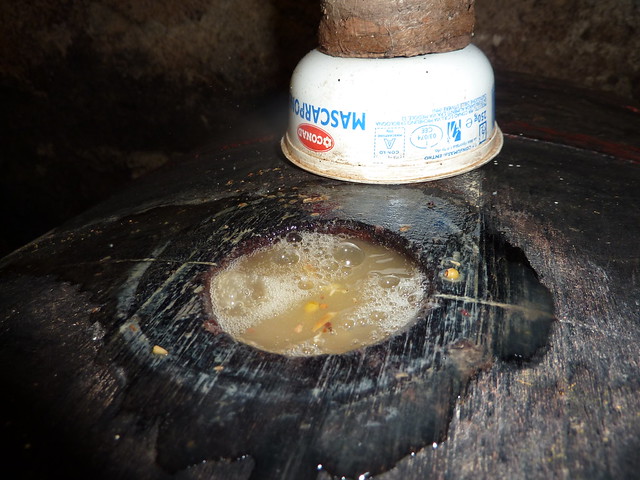
Of which luckily there were loads still in our cellar, good job we did not clear out completely when we moved in! First we had to get the wine home to our own Cantina, the room above our cellar, which B and A actually refer to as our ‘Tinaio’ which I cannot find in any of our Italian dictionaries. This word even confused Google Translate, although I know that is not actually difficult to do, providing no translation at all. Someone somewhere might be able to translate this for us, the word is obviously in local usage still as even our geometra used it when drawing up the plans for the house during renovation! Anyway it is a very useful storage room where we store any produce in jars, fruit and vegetables are overwintered, plus we keep a freezer and a gas burner where we prepare large scale preparation of fruit and vegetables for bottling and jams etc. When we moved to Italy we had no idea that we would be going back in time a generation to a way of life that was normal to our parents and a novelty we soon abandoned when we first married in the early seventies!
Anyway I digress, to transfer the wine we used 20 litre sized plastic water carrier style containers and then transferred it again into the largest green glass demi johns from our cellar. We were shown and told how important it is to keep these bottles completely full, some top up liquid having been saved in smaller bottles just for this purpose. While this fermenting process is going on it is very important to cover but not seal the bottles, otherwise they will explode. We were told most specifically that the wine will be ready for sealing on St Martins Day, which I now know having checked the calendar is November 11th. We will be guided through that process and in the meantime kept an eye on to make sure we are topping up the liquid in the demi johns on a daily basis. I assume that we will then be told to prepare for bottling.
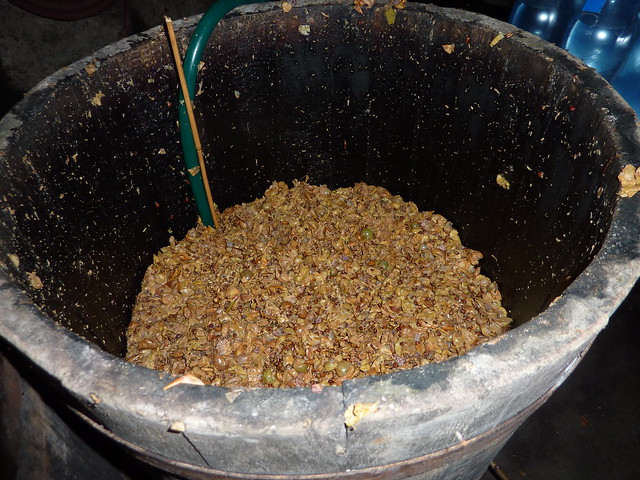 Pulp left after draining.
Pulp left after draining.
The last three photos are back home in our ‘tinaio’ where we transferred the wine into our demi-johns.
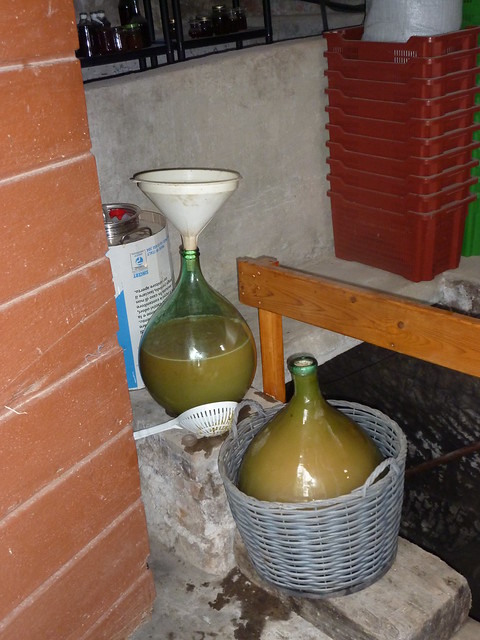
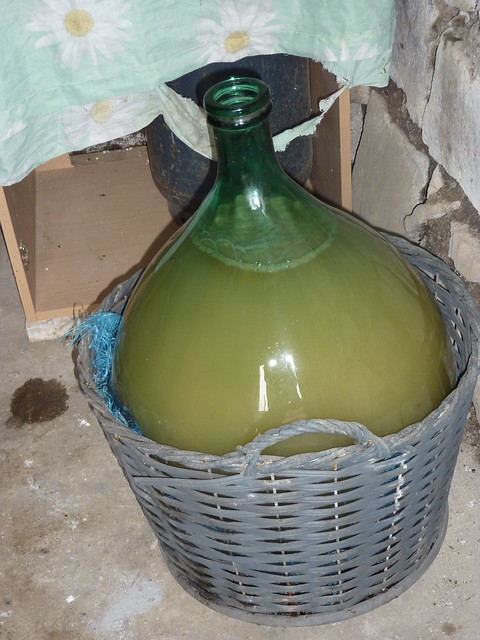
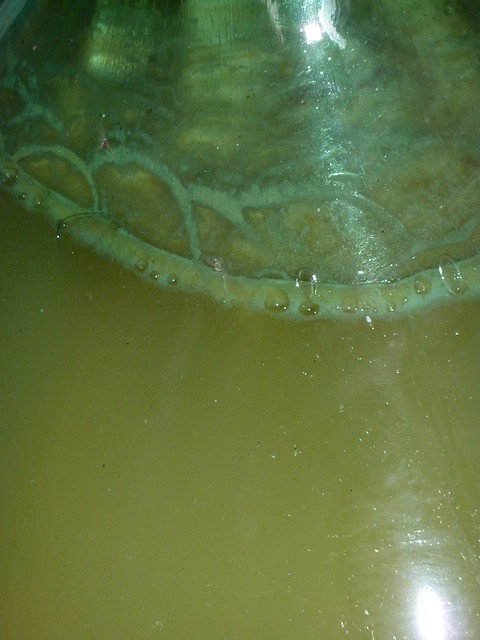
After our wine making lesson for the day, we were joined by B and A to help us harvest the last of our apples, as in return for the grapes they have agreed to take some of our surplus apples. Apples,Apples,Apples This is good news as we hate seeing them go to waste and even better they have taken not just the last apples from the trees but also all the windfalls. Which along with any damaged apples will be fed to the pig that is already here being fattened up ready for January. What happens in January you may ask, why the Annual Pig Celebration Lunch Annual Pig Celebration Lunch of course!
Life is still lived very much by the seasons using produce that the land and their hard work provides for this kind Italian couple. Without a doubt they are not unusual here, there are very many families all over Italy that still live this type of life controlled by the rhythm of the seasons.
I have only posted a selection of photos from the Winemaking Process in these posts, if you are interested in viewing the full album at Flickr please visit, Grape Harvest 2010.
I can just smell it! My grandfather and father used to make wine when I was small. Actually it was more vinegar, but a very good one!
ReplyDeleteI enjoyed reading your post. Two thoughts came to mind: We just returned from Napa Valley, CA where we visited the wine caves at Mondavi winery. They did not look anything like your delightful second picture and they did not use a plastic marscapone container to cover the opening...how much is lost in pristine modern technology! I could stand in your second picture, close my eyes and smell all the aromas!
ReplyDeleteSecond thought: we were able to taste new wine in Germany once that was called something like, Fesservisson that cannot be tightly capped because it is still fermenting and has a fizziness to it.
I will ask my friend about the word "Tinaio"...how I would love such a room.
What a wonderful way of life to live by the seasons. You have an amazingly rich life in Italy. Its great that you are living your dream. Isn't it interesting that they use no additives. I can only drink Italian wine. I'm really sensitive to the additives. Now I know why its my wine of choice. Have a great day! Susan
ReplyDeleteThere's a danger of explosion?? Good thing you have some helpful guides through this amazing experience. It sounds fascinating!
ReplyDeleteOh wow!! This is really IT!! We've seen that at Walt and Ken's neighbour's - Mr. Geurrier!
ReplyDeleteAlso, just made applesauce.. Apples are REALLLLY in season and selling sooo cheap here right now!
This is so fascinating – I really had no idea of this process. But I am encouraged to read that wine is still made without preservatives – I love wine but have a very bad reaction to most wine. Looks like I just need to get some made like this!
ReplyDeleteWow. That's pretty darn cool . . all this winemaking.
ReplyDeleteLucky little piggie.
D
Scintilla - Well I hope it does not turn out as vinegar or smell like it :)
ReplyDeletePatricia - So pleased it was of interest, the lack of technology is part of the attraction. The reason the wine is not covered is that the yeast and the sugar are evolving into alcohol and Carbon Dioxide as part of the fermentation
process, so must not be put under pressure yet.
Neil and Susan - We also think your lifestyle looks pretty great as well! I cannot say if commercially made Italian wine has additives, but if it suits you no problem.
Natalie - If it is sealed too early yes it does!
Leesa - Yes this is it! As for apples they should be cheap there was such a surplus this year, well around here anyway, we had trouble giving them away.
Georgianna - Maybe you should try Italian wine, one of the earlier commenter's is allergic to additives in wine and it seems Italian wines are the only ones she can drink.
Dana - I know, all good fun here!
A "tinaio" is where you store the "tini" (a "tino" is one of those big open barrells in the first picture). I suggest you read a beautiful poem by the Nobel awarded Giosue Carducci ("San Martino") who used this ancient word.
ReplyDeleteAre you sure the geometra wasn't talking about the "tinello" instead (=italian for the "lounge")?
An Italian reader
Thanks for stopping by Lindy...I always love reading your comments. :) Looks like you had a great time making wine. That's something I've never done, but would love to try.
ReplyDeleteAs far as the Christmas lights..here in MN it's easier to put them up when it's a bit warmer, rather than when it's snowing and 30 below F. Plus, my grandparents are at an age where they aren't able to hang them up themselves, so we were just helping out. However, I find it interesting that I see lots of Christmas items and decorations up in stores already...I'm sure the Christmas music will be playing on the radio soon, too. haha
I hope you have a lovely day!
Fascinating! I just hope that the wine is drinkable.
ReplyDeleteBeautiful post! My father in law is doing the same this week :) All alone, because no one of us could go and help him this year... beautiful series of shots too. Well done!
ReplyDeleteWhat a great blog..You know I have made Rhubarb wine/blueberry too..Not crazy about my wines..but I cook with them so it isn't wasted..
ReplyDeleteMade beer once too..used that for bread. I do make jams/jellies, which is where I do have luck.
Anyway, there is nothing like making your own stuff..My mom was Polish and she did everything..Your always wealthy when you have the pantry full..My kind of wealth..ha, ha..
Have a good week Lindy..Carolyn/Rosebud
Anon - thanks so much for taking the time to comment and let me know the meaning of 'tinaio'. It was definitely this room our geometra was referring to. I will definitely find and read the poem. San Martino's is when we have been told we have to carry out the next stage of the winemaking process!
ReplyDeleteDawn - It has been fun, thanks for explanation 30 below is rather cold!! It is also very thoughtful of you to do this task for your grandparents. Christmas is coming I better start making plans :)
Cheshire Wife - My main concern, lets hope so!
Kia - Thanks for your kind words, I expect your father in law enjoys the process even having to work alone, the locals here certainly seem to take a lot of pleasure in such tasks.
Carolyn - Thankyou for your kind words. We used to make wine like you describe in the UK many many years ago, not always a great success, friends have never let us forget a certain year when we made runner bean wine which was disgusting!
Interesting process! I have an Italian friend whose dad does the same and have big barrels for a whole year or two!
ReplyDeleteTinaio I thought came from the word tina or tino (container). Tinaio is a place for those containers.
Simony - Thanks much appreciated, your translation seems to fit with the one from Anon about the open barrels. I am going to look out and read the poem they mention.
ReplyDeleteI had no idea about all of the processes involved with wine-making...you are very patient! I would just want to drink it straight away! Hope it turns out beautifully.
ReplyDeleteBest wishes,
Natasha.
Linda , I have been having a great time reading the various blogs as well as yours ,of course, and enjoying the photos , I have always wished for a wisteria vine, yours is lovely .How is David,busy as usual, i am sure . Best wishes , Joyce .
ReplyDelete